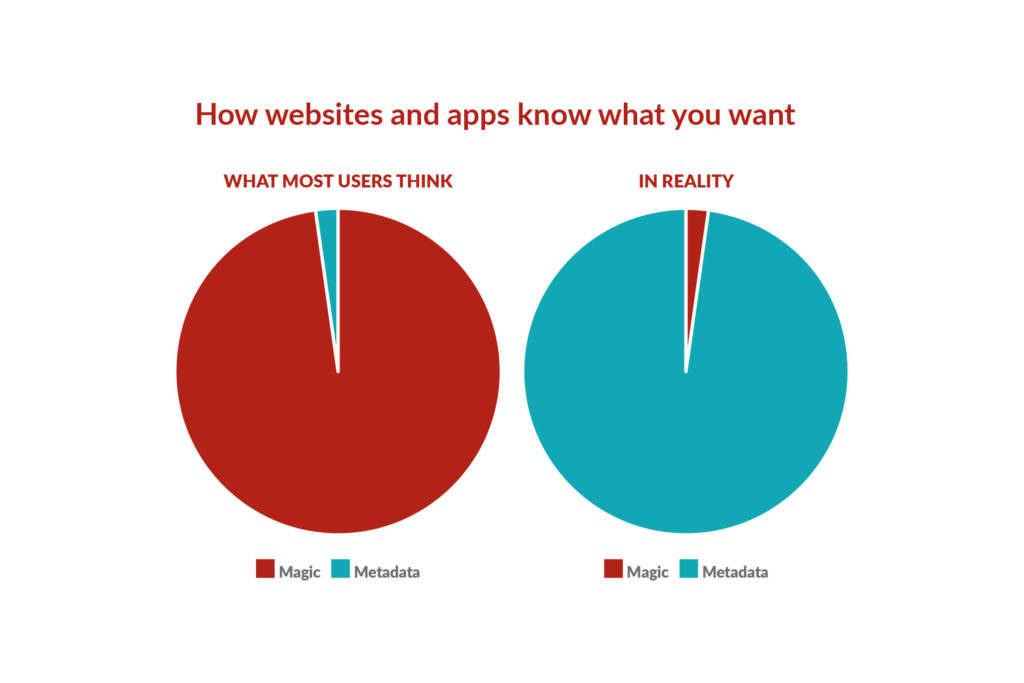
Last week, I ended up on my partner’s Netflix profile by accident. I winced, repulsed. Gone were my ‘Quirky, Heartfelt and Irreverent’ films, replaced by a sea of ‘Action, Riveting and Dark’ offerings.
Sure, it was still Netflix, but it wasn’t ‘my’ Netflix.
Once I finished gibbering, I got to thinking. We live in the same house. We watch the same TV. We even share the same Netflix family account. So why does his Netflix page feel like stepping into enemy territory whilst mine feels like coming home?
The answer lies in Netflix’s data, all 60 million billion bytes of it.
A business built on metadata
A glance at its metadata template for partners shows the information that Netflix requires for new content, including title, season number, episode number and country of origin. Yet, helpful as these facts are, they hardly contain the information Netflix needs to recommend the perfect match for each of its 200 million users.
Instead, that requires the human touch provided by metadata analysts, also known as taggers.
Taggers are responsible for collating more subjective information, such as the ‘quirkiness’ of a central character or the ‘completeness’ of a plot. The result, according to The Atlantic, is over 75,000 different micro-genres of films and shows. These collectively form a ‘stockpile of data about Hollywood entertainment that is absolutely unprecedented.’
Of course, knowing about its content is only half of the story. To make successful recommendations, Netflix must also understand every user’s viewing habits and preferences, including what we watch, when we watch and what devices we watch on. This data and associated metadata enable Netflix’s personalisation algorithms to be so successful that over 80% of streamed content is based on their recommendations.
The result is one we’re all familiar with: the feeling that Netflix knows us better than we know ourselves.
Of course, Netflix isn’t alone in relying on metadata to delight its users. Many other popular websites use their vast metadata catalogues to enhance their service delivery…
Our working parents’ favourite site for saving their bacon
Any parent knows the feeling of dread caused by a child giving you two days’ notice that they MUST go to school on Friday dressed as a World Book Day character, princess or caveman.
Years ago, parents would have frantically bodged together a homemade costume. These days our busy employees and other parents everywhere turn to the huge metadata catalogue that is Amazon. Nick Turner, Head of Product, explains, “Amazon uses metadata to narrow our search for the perfect item, allowing us to select a costume by character name, age, price and – most importantly of all – its availability on Prime.”
Jill’s favourite site for avoiding awkward first dates
In the old days, we met our partners at work, on a night out or via recommendation from a friend. Times have changed. Now, according to Stanford, couples are more likely to form a relationship through online dating than any other avenue.
With millions of potential partners registered on dating sites, metadata plays an essential role in filtering out those who don’t tick our boxes. Our Marketer, Jill Davis, explains, “Having been set up on a disastrous first date by friends, I was surprised to find that a dating website did a far better job of matching me with someone I actually had something in common with. We’re still together 11 years on so the site must have done something right!”

Everyone’s favourite site for finding answers
When we were kids, we thought our parents knew everything. Now our kids think the same… about Google.
Having started crawling the internet gathering metadata about web page links and link backs (PageRank) from other sites to build its catalogue of web pages, this giant data store now sets its own metadata requirements. As a result, marketers everywhere expand vast amounts of effort in the hope of providing the quality metadata Google needs to boost their search engine ranking.
From a user perspective, Google’s vast metadata holding enables us to quickly find answers to all sorts of questions, however niche. It’s just a shame it can’t help us find our keys as easily as it can suggest a recipe for gluten-free vegan brownies.
Recently, our Metadata Expert, Jo Cook, was paid the ultimate compliment by one of our clients. When asked where he would turn to for information, he replied, “Google… and Jo.”
Making your metadata earn its keep
This year, we’re developing SEO tools that make it easier for data publishers to optimise their geospatial data for Google and other search engines. You can find out more in our new Guide to Data Discoverability.
Further reading:
Find out the downsides to being a Netflix tagger in Kelly Woo’s ‘Binge-watching Netflix for a Living’.
Discover more about different Netflix genres in ‘How Netflix Reverse-Engineered Hollywood’ by Alexis C. Madrigal.
Learn how Netflix uses personalised images to drive clicks in Josefina Blattman’s fascinating article for UX Planet.
Google Trends turned 15 this year. Find out what we were all searching for back in 2006.

2 Responses
Great blog very informative and interesting as you related it o Netflix which most people are familiar with. Metadata and SEO are the future, garlic bread is old hat now.
Every business should consider how Metadata can enhance their operation, I’d encourage readers of this blog to sit back and think out of the box. What does this mean to me, to us, to our customers ? How can Metadata help us improve, save money even make money. Very thought provoking…